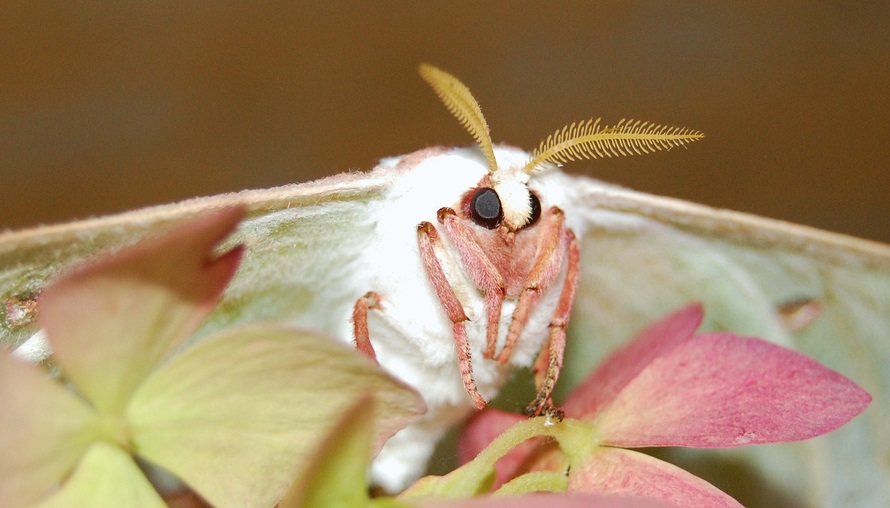Wildlife Wednesday: Those Magnificent Moths
Moths don’t get quite as much attention and adoration as their showier day time counterparts, the butterflies, but they are just as fascinating and often just as beautiful. While most moths we think of are drab colored browns and grays, some moths can be quite colorful and frankly quite adorable. Moths and butterflies are both members of the insect order Lepidoptera, and have a lot in common. They both have an egg-caterpillar-pupa-adult life-cycle. They usually both have long extendable curled straw like sucking mouth parts (though some moths do not have mouth parts at all). Also, both groups tend to have large wings with scale like structures on them that give them their coloration.
There are differences, of course. Moths are usually nocturnal, while butterflies are diurnal (daytime). Butterflies have antennae with a small club like structure at the end, while moths have simple thin or ornate feathery looking antennae (both without clubs). Moths sometimes encase themselves in a silky cocoon as a pupa/chrysalis, while butterflies never do. The difference between the two groups is actually somewhat more complicated than night/day and coloration, as moths actually have varied bodies and lifestyles. Therefore, scientists group some families of Lepidoptera together and call them “moths”, and do the same for some families which they call “butterflies”. So there aren’t always hard and fast rules for considering them into one or the other, but more a history of conventional thinking.
Today, we have a look at 3 of the more common and noticeable moths in the Houston area.
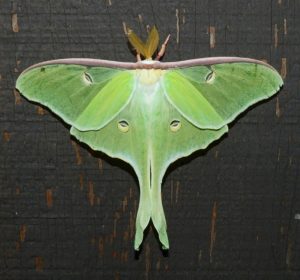 The Luna Moth (Actias luna) is a large nocturnal green moth in the silk moth family Saturniidae. As with most moths in this family, they do not have mouth parts, and thus do not feed as adults, having received all the nutrients they need to carry out their lives, as larvae (caterpillars). This is indeed a large moth, with a wingspan of up to 4.5 inches across. They have long tails on the hind-wings, which give them a swallowtail like appearance. The plump green caterpillars, with small soft spikes and red bumps, feed on a wide variety of tree leaves. They spin a silken cocoon in leaves, where they turn into pupae, and later emerge from, Spring through Summer in the Southern U.S.
The Luna Moth (Actias luna) is a large nocturnal green moth in the silk moth family Saturniidae. As with most moths in this family, they do not have mouth parts, and thus do not feed as adults, having received all the nutrients they need to carry out their lives, as larvae (caterpillars). This is indeed a large moth, with a wingspan of up to 4.5 inches across. They have long tails on the hind-wings, which give them a swallowtail like appearance. The plump green caterpillars, with small soft spikes and red bumps, feed on a wide variety of tree leaves. They spin a silken cocoon in leaves, where they turn into pupae, and later emerge from, Spring through Summer in the Southern U.S.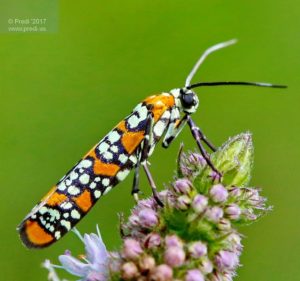
The Ailanthus Webworm Moth (Atteva aurea) is a colorful micro-moth, in the ermine moth family Yponomeutidae,, active during the day and night. They are quite small at only about 1 – 1.5 cm long. This moth is not historically native to the United States, but has moved into the Eastern U.S. as people have planted non-native host plants for their larvae (though not intentionally) across the country. The caterpillars feed on Tree-of-Heaven (Ailanthus sp.), a landscaping plant from China, as well as Paradise Tree from the American Tropics. Ailanthus Webworm Moths have seasonal movements, and often appear in Houston in great numbers in mid to late Autumn. The adults feed mainly of flower nectar.
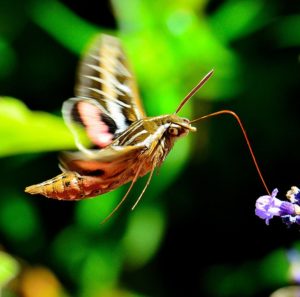
The White-lined Sphinx Moth (Hyla lineata) is a large thick-bodied moth that is often mistaken for a hummingbird, if one is not looking closely. They are in the Sphinx Moth/Hawk Moth family Sphingidae. Unlike most of the moths you may know, this is a daytime (diurnal) moth, which spends its days flying amongst flowers and hovering while it feeds on flower nectar. They are found flying from early Spring to late October in the Southern U.S. Northern populations of this Sphinx Moth will migrate to the South to finish out their lives or overwinter. Though moths are known to make cocoons, this family of moths does not. The White-lined Sphynx caterpillars, which feed on a variety of tree and vine leaves, burrow into the soil or under logs or dead leaves, and turn to a pupa/chrysalis there in their subterranean lair. Maintaining ample leaf litter under trees and bushes around your home can help out Sphinx moths to complete their life cycle. Also, just as are butterflies and bees, nectar feeding moths, such as this species, are important pollinators, and contribute important services to human agriculture, home gardens, and natural eco-systems.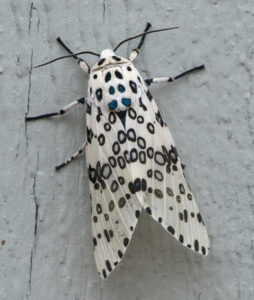
There is actually an incredible diversity of moths that occur in the Houston area, some throughout the year and some only in the fall or spring, as they migrate through. Many of these species are active at night, so we may not notice them and what they do for us as much as we would more obvious daytime creatures. They are however, just as important.
(Find out more: Gardening for Moths)
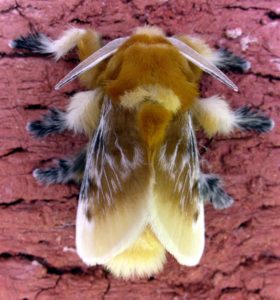 Thanks for joining us today, come out to the park some time and see if you can spot some our Houston area moths! tag us on Instagram (#naturediscoverycenter), if you photograph any moths in the park or in your own yard at home!
Thanks for joining us today, come out to the park some time and see if you can spot some our Houston area moths! tag us on Instagram (#naturediscoverycenter), if you photograph any moths in the park or in your own yard at home!
See you soon!
Eric Duran
Staff Naturalist
Photos: Luna by Rob Swatski | Flickr; Luna by Jim Mullhaupt | Flickr; Ailanthus by Predi | Flickr; Sphinx by Larry Lamsa | Flickr; Giant Leopard Moth by Ronnie Pitman | Flickr; Puss Moth by Patrick Coin | Wikipedia


